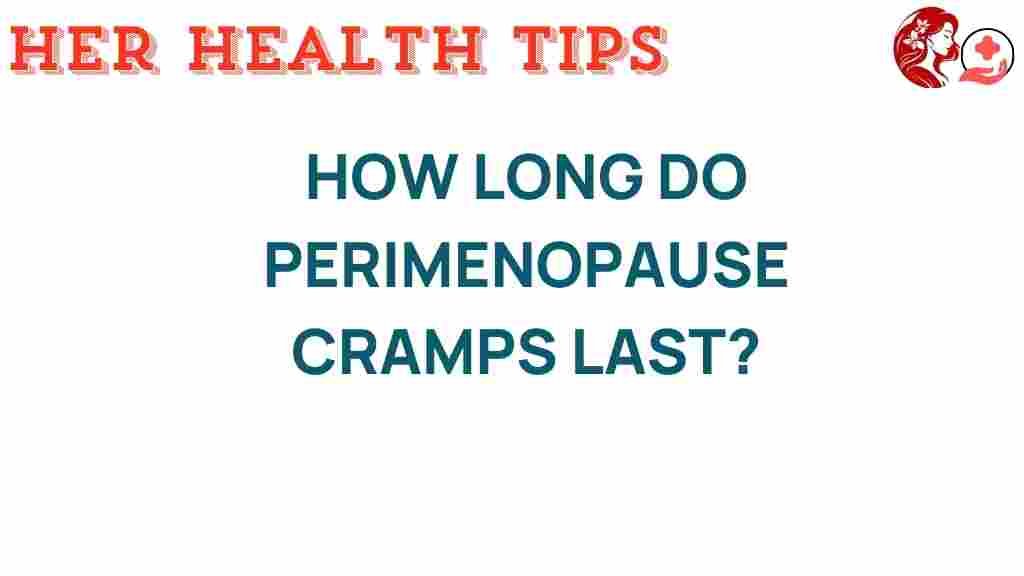Unraveling the Mystery: How Long Do Perimenopause Cramps Last?
Perimenopause is a transitional phase that many women experience as they approach menopause. This period is marked by various symptoms, including hormonal changes that can lead to discomfort such as perimenopause cramps. Understanding the duration, symptoms, and relief methods for these cramps is essential for managing women’s health effectively. In this article, we will delve into the intricacies of perimenopause cramps, providing you with the knowledge you need to navigate this significant life transition.
What Are Perimenopause Cramps?
Perimenopause cramps are abdominal pains that women may experience as they transition into menopause. These cramps can vary in intensity and duration, often resembling menstrual cramps. During perimenopause, the body undergoes significant hormonal changes, primarily involving estrogen and progesterone, which can affect the menstrual cycle and lead to discomfort.
The Duration of Perimenopause Cramps
The duration of perimenopause cramps can vary significantly among women. Generally, these cramps may last for:
- Days to Weeks: Some women experience cramps that last for a few days during their menstrual cycle, while others may have discomfort that persists for weeks.
- Irregular Patterns: Cramps may not occur in a regular pattern, as the menstrual cycle can become irregular during perimenopause.
- Intensity Fluctuations: The intensity of cramps can also fluctuate, with some months being more painful than others.
It is essential to note that while cramps may be common during this transition, they can also indicate other health issues. Therefore, keeping track of symptoms and their duration can be helpful for discussions with healthcare providers.
Symptoms Associated with Perimenopause Cramps
In addition to cramps, perimenopause can bring about a variety of other symptoms that affect women’s health. These include:
- Hot Flashes: Sudden feelings of warmth, often accompanied by sweating.
- Irregular Periods: Changes in menstrual cycle frequency and flow.
- Mood Swings: Emotional fluctuations that can affect daily life.
- Sleep Disturbances: Difficulty falling or staying asleep.
- Vaginal Dryness: Reduced lubrication, leading to discomfort during intercourse.
Recognizing these symptoms can help women understand what they are experiencing during the menopause transition and seek appropriate relief methods.
Understanding Hormonal Changes During Perimenopause
The hormonal changes during perimenopause are primarily due to the fluctuations in estrogen and progesterone levels. These hormones regulate the menstrual cycle, and as they fluctuate, they can lead to:
- Altered Ovulation: Irregular ovulation can result in unpredictable menstrual cycles and varying levels of menstrual discomfort.
- Uterine Contractions: Changes in hormone levels can lead to increased uterine contractions, contributing to cramps.
- Inflammation: Hormonal imbalances can cause inflammation, exacerbating pain and discomfort.
Being aware of these hormonal changes can empower women to take proactive steps in managing their symptoms.
Relief Methods for Perimenopause Cramps
Managing perimenopause cramps can involve various relief methods, ranging from lifestyle changes to medical interventions. Here are some effective strategies:
Lifestyle Changes
- Regular Exercise: Engaging in physical activity can help reduce cramps and improve overall well-being.
- Healthy Diet: Consuming a balanced diet rich in fruits, vegetables, and whole grains can support hormonal balance.
- Stress Management: Techniques such as yoga, meditation, or deep-breathing exercises can help manage stress levels and alleviate cramps.
Over-the-Counter Medications
Non-prescription pain relievers, such as ibuprofen or acetaminophen, can help alleviate cramps. Always consult with a healthcare provider before starting any medication.
Alternative Therapies
- Heat Therapy: Applying a heating pad or hot water bottle to the abdomen can soothe cramps.
- Acupuncture: Some women find relief through acupuncture, which may help balance hormones and reduce pain.
- Herbal Remedies: Certain herbs, like ginger or chamomile, may provide relief; however, always consult a healthcare provider before trying new remedies.
When to Seek Medical Advice
While perimenopause cramps are common, there are instances where medical advice is necessary. Consider seeking help if:
- The cramps are severe and debilitating.
- There are significant changes in menstrual cycle patterns.
- Accompanying symptoms include heavy bleeding or unusual discharge.
- There are concerns about other health conditions.
Consulting with a healthcare provider can help rule out other potential issues and ensure that the symptoms are part of the normal menopause transition.
Conclusion
In summary, perimenopause cramps are a common experience for women during the menopause transition. The duration and intensity of these cramps can vary widely, influenced by hormonal changes and individual health factors. By understanding the symptoms, recognizing the hormonal fluctuations, and employing various relief methods, women can better manage their discomfort during this significant life change.
Remember to keep track of your symptoms, consider lifestyle adjustments, and consult with a healthcare provider when necessary. For more information on women’s health and managing perimenopause symptoms, visit Women’s Health Organization.
As you navigate through this phase, know that you are not alone. Empower yourself with knowledge and take proactive steps toward relief and well-being.
This article is in the category Reproductive and created by HerHealthTips Team
